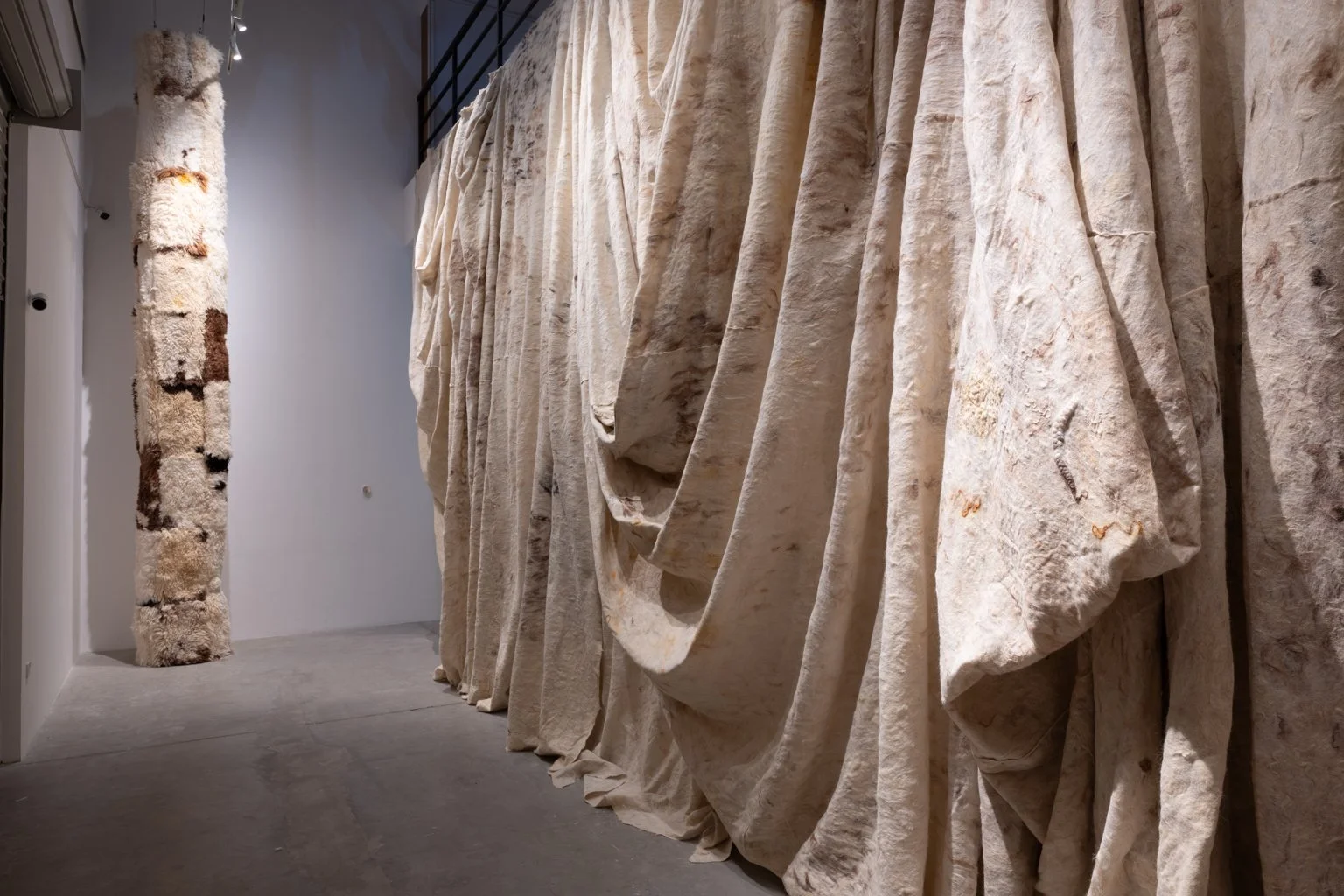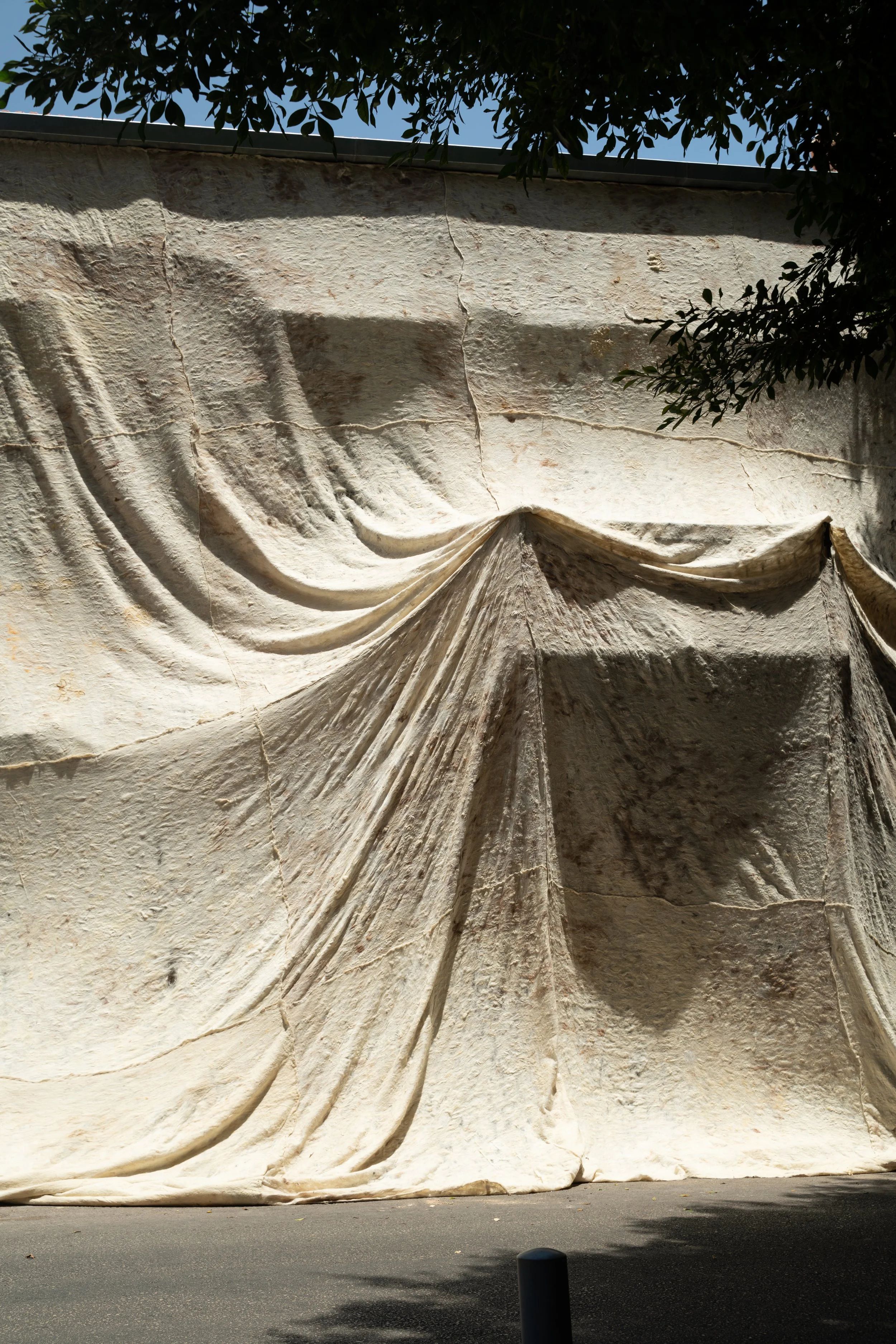Adrian Pepe: A Shroud is a Cloth
This review was originally published by STIR, Feburary 20, 2025.
The Honduran fibre artist delves into the interconnectivity between humans and animals and explores concepts of healing, destruction and repair in his latest exhibition in Dubai. By Anna Seaman.
Adrian Pepe. A Shroud is a Cloth, exhibition view, (2025). NIKA Project Space Dubai. Image: Liana Mukhamedzianova; courtesy of NIKA Project Space
Deep voluminous pleats that pool slightly at the floor and hang from ceiling level give artist Adrian Pepe’s curtain installation a kind of regal grandeur reminiscent of a royal bedchamber. The scale of the artwork, which stretches across the entrance of the gallery and presents a threshold between Pepe’s exhibition and the outside world, adds to its drama. Yet, upon closer inspection, this curtain is a far cry from opulence; nor does it have a utilitarian purpose. It is a hand-felted material; a gritty, rough mesh, surprisingly lightweight and fragile, fashioned from sheep wool. Pepe, a fibre artist originally from Honduras in Central America, lives and works in Lebanon. He made the work for a public installation in Beirut in 2024, where it wrapped a building damaged by the city’s devastating port explosion four years prior. For this exhibition, the work has been resized and renamed. The largest portion, Shroud (2024), gives this exhibition at NIKA Project Space its title: A Shroud is a Cloth.
Adrian Pepe. Entangled Matters 2.0. Exhibition View. Beirut. 2024. Courtesy of the artist.
The Beirut project, titled Entangled Matters 2.0, was an exploration of the process of healing. “Immediately after the port explosion, all the buildings were covered with sheets of material; like a kind of bandaging as they went through repair,” says Pepe. “I made a connection between urban bodies and human bodies and that is why I wanted to wrap the building with wool because wool is also used as a bandaging material for the body.”
The original artwork stretched over 200 square metres around the façade of Villa des Palmes in Beirut’s Sursock area. Upon moving it to Dubai, he divided it and used the largest portion for the entranceway of the gallery. “What does it mean to display an artwork in a space that is out of context from its original setting or purpose?” Pepe ponders. “This piece is now an artefact of an act, which goes beyond its materiality and holds tension. It carries with it a memory and a story of its own.”
Adrian Pepe, 2022. Photo courtesy of the artist.
“I am interested in the role of material through moments of transition,” Pepe notes about his practice. This exhibition marks his first solo show at NIKA, the gallery that supported his Beirut installation and his participation in the Sharjah Architecture Triennial in 2023 with a presentation in the city’s old slaughterhouse. All works in this current show are derived from a single common source: wool. “Wool has this capacity to hold time—it is resilient yet malleable, intimate yet expansive,” says Pepe. “In this exhibition, I am exploring how materials are never neutral; they shape and are shaped by care, labour and the environments they inhabit.”
Pepe is fascinated by what happens to a material once it loses its intended purpose or use. His Sharjah Architecture Triennial presentation, Utility of Being: A Paradox of Proximity, is partly showcased in this exhibition with a single work that stands as a totem, constructed from sheep pelts stitched together and inflated using an internal air blower. “Skin is a natural carrier and here, I wanted to allow this skin, this postmortem biomass, to be filled with air so that it is breathing. It was first exhibited in a slaughterhouse, a place of transition and for this exhibition, it stands tall, overlooking everything and reclaiming its purpose.
Untitled, hand-felted wool, 2025, Adrian Pepe. Image: Liana Mukhamedzianova; Courtesy of NIKA Project Space
The particular wool he uses, that of the Awassi sheep native to the Middle East, was once a widely used utilitarian material but is often discarded by farmers today because it has little commercial value compared to softer imported wools like cashmere and merino. Pepe is particularly interested in this transition. “I gathered unprocessed discarded wool and started to cleanse it, manipulate it and connect with it,” he says. “To me, it became a material that has something to say, and I am giving it a voice.” Other works in the show include Urban Shroud #1 (2022), which combines pieces of jute that Pepe sourced from the scaffolding of damaged Beirut buildings with hand-felted wool and embroidered works that celebrate the roughness of the material. There is also a series of pieces made up of waste products collected during the wool’s cleansing process. Vegetable Matter (2025) contains seed pods, plant matter and insects trapped in animal collagen and conserved with medical-grade preservatives. Landscape Matter (2025) includes smaller works formed from dust and debris and bound together in the same way. “These pieces exhibit the process of capturing nature through nature,” he says. “An attempt to immortalise the memory that the material holds.”
Adrian Pepe. A Shroud is a Cloth, 2025. Exhibition view. Image: Liana Mukhamedzianova; Courtesy of NIKA Project Space
One of the most arresting works is Shedding (2023), a video work documenting a durational performance in which wool was wet-felted directly onto the artist’s skin over 12 hours during a residency for the Saudi Ministry of Culture. The process formed a life-sized cast that enveloped his entire body, only to be shed at the performance’s end—like the sloughing of a second skin. In the Dubai exhibition, the video is displayed alongside the cast, now resting in a glass vitrine, evoking the stillness of a funeral casket. This juxtaposition encapsulates Pepe’s conceptual engagement with wool—once a living substance, now oscillating between utility and discard. The work prompts viewers to confront their own materiality and mortality while reconsidering the entangled relationships between humans and animals. “When I eat meat, I consume the biomass of another,” he says. “Here, I wanted to flip the narrative and allow the animal to consume my body with its biomass. I enveloped the animal at a certain point [when I ate it] and, in this performance, I allowed the wool to completely envelope me.”
Adrian Pepe. Shedding, 2024.; video and glass encased work). Installation view. Image: Liana Mukhamedzianova; Courtesy of NIKA Project Space. (video and glass encased work)
The dialogue between species, between sentient and inert matter, between destruction and repair set the tone for this exhibition and, as Veronika Berezina, founder of NIKA Project Space, says, acts as a reminder of the delicate balance that sustains our world. She says: “Through his research, Adrian has delved into the interconnectivity of life, bridging humans, nature and raw materials in a way that reveals the hidden threads that bind us all.”
Adrian Pepe: Shroud is a Cloth. January 29 - May 17, 2025. NIKA Project Space in Dubai.






